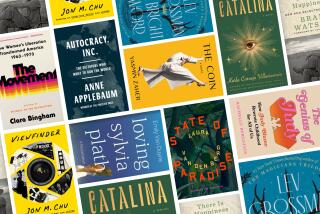DISCOVERIES
- Share via
A Day at the Beach
A Novel
Helen Schulman
Houghton Mifflin: 224 pp., $24
AS noted elsewhere in these pages, novels set in the days following Sept. 11 now form their own literary genre, elaborating on that terrible day and the effects that ripple outward from it. Gerhard Falktopf is a likable (if self-absorbed) fiftysomething choreographer who emigrated from Germany at age 17 and is now in the process of losing control of the dance company he worked so hard to build. His 36-year-old wife, Suzannah, who is also his muse and his former prima ballerina, has stopped dancing to raise their son, Nikolai.
The couple watch from their downtown loft as the twin towers collapse. Gerhard puts his family, his au pair and a young French mother and baby he met at the ATM that morning into the car and flees to Easthampton, to the house a wealthy patron has lent him. The little group reminds you of that in Boccaccio’s “Decameron,” safe for the moment, granted a brief reprieve in a beautiful place to ponder their lives.
**
Four Seasons in Rome
On Twins, Insomnia, and the Biggest Funeral in the History of the World
Anthony Doerr
Scribner: 224 pp., $24
ANTHONY DOERR is a worrier. He worries about his 6-month-old twin boys, about international disasters, about the Roman traffic, about the pope, about his career.
He receives a fellowship from the American Academy in Rome to work on his second novel, whereupon he and his wife, Shauna, haul the twins, seven duffel bags and a stroller to Rome to set up house for a year on the Janiculum Hill, above Trastevere. Instead of writing, he reads Pliny’s “Natural History,” which causes him to worry about how little he understands: “[W]e ought to understand the earth we live on, its skies, its stones.... But I don’t even understand the apartment building in which I live. How is linoleum made? Or window glass, or porcelain?” On time: “Here’s another duality of Rome: the way time here feels simultaneously immense and tiny.” On winter: “Winter in Rome is a breath of daylight, then limestone and shadow: light glowing behind closed shutters as though stacks of gold are hoarded inside.” Spring: “not so much a season in Rome as an onslaught of colors: silver, gold, green.”
Overwhelmed (by Rome and sleep deprivation), he agrees with Eleanor Clark’s arch observation, in “Rome and a Villa,” of the city’s sheer “too-muchness.” These and other musings make “Four Seasons in Rome” a pleasant sort of nervous breakdown on paper -- pleasant not only because of the clarity and whimsy of the author’s prose but also because it is (let’s be honest) someone else’s nervous breakdown.
**
The Five-Forty-Five to Cannes
Stories
Tess Uriza Holthe
Crown: 288 pp., $23.95
LINKED stories, done subtly and well, resemble the way we live: how our thoughts sail on the barest of threads from one thing to the next. “The Five-Forty-Five to Cannes” is more like a necklace of glittering beads than any other art form to which the short story might be compared. Or like a relay race.
It begins with Chazz Jorgensen, good-looking black-sheep scion of an alarmingly wealthy family, who has gone off his lithium. He sits in a favorite Cannes cafe, hoping to recapture something of himself in order to save his dead marriage. The baton is passed: to a woman who sees him, to her self-involved daughter-in-law, to a pickpocket on the 5:45 train and so on. The stories are also linked by sparkling detail; pigeons, chestnut trees, paintings, lavender eyes, the incantatory names of towns in the South of France: Juan-les-Pins, Cagnes-sur-Mer, Antibes.
*
More to Read
Sign up for our Book Club newsletter
Get the latest news, events and more from the Los Angeles Times Book Club, and help us get L.A. reading and talking.
You may occasionally receive promotional content from the Los Angeles Times.







